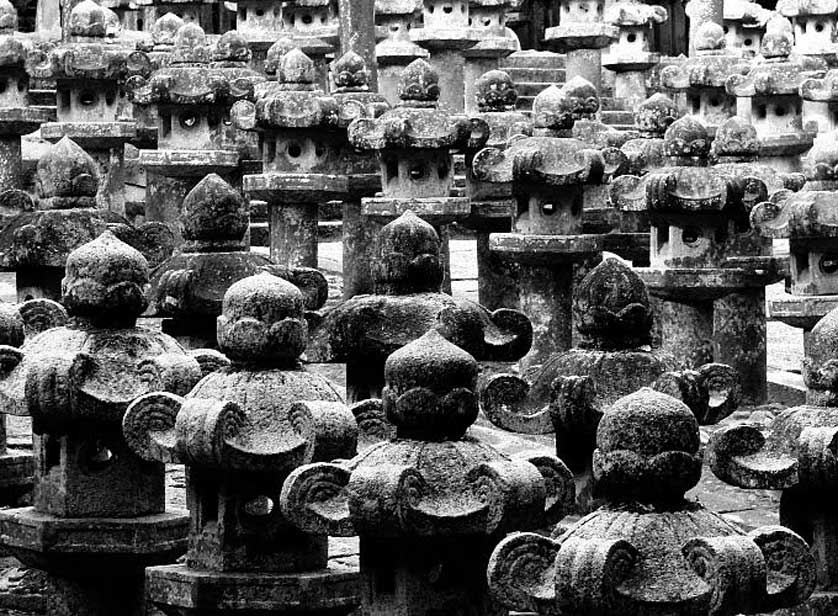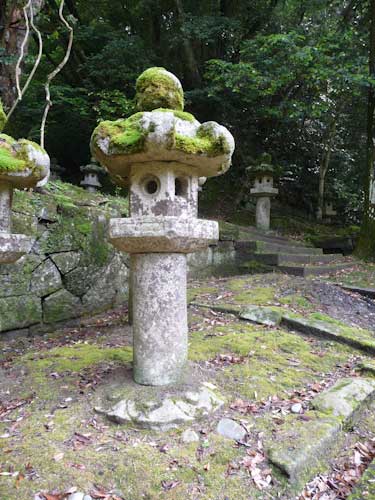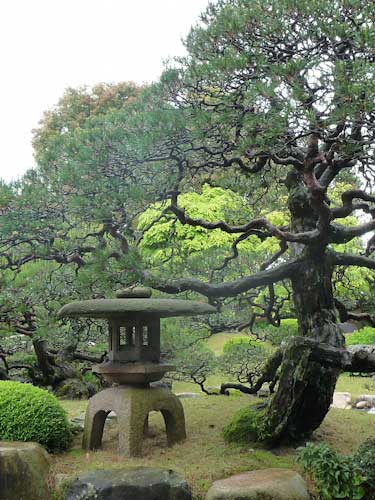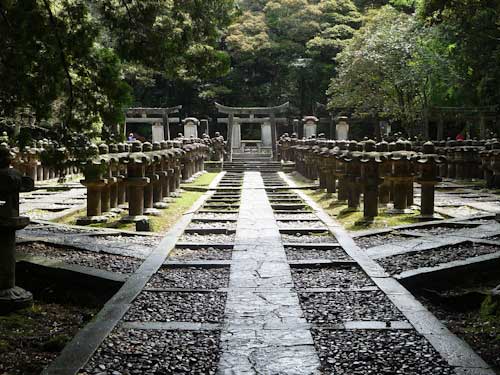Stone Lanterns in Japan: A Journey Through History, Culture, and Design
- Published on : 18/07/2024
- by : Japan Experience
- Youtube

Ranks of stone lanterns at Daisho-in, Hagi, form pleasing patterns by daylight, and are magical when lit at night
Stone lanterns, or ishidoro in Japanese, are iconic elements of Japanese gardens, temples, and shrines. These elegant structures have been illuminating paths and adorning landscapes for centuries, serving both practical and symbolic purposes. From their origins in ancient China to their evolution in Japan, stone lanterns have become an integral part of Japanese aesthetics and cultural heritage. Join us on a fascinating journey through the world of Japanese stone lanterns, exploring their history, types, symbolism, and enduring appeal in modern times.
The Origins and Evolution of Stone Lanterns in East Asia
The story of stone lanterns begins in ancient China, where they were first developed during the Han dynasty (202 BCE-220 CE). These early lanterns were primarily used in Buddhist temples as votive lights, symbolizing the illumination of Buddha's teachings. As Buddhism spread across East Asia, so did the use of stone lanterns.
Stone lanterns were introduced to Japan from China via Korea during the 6th century, coinciding with the arrival of Buddhism in the country. Initially, they were used exclusively in Buddhist temples, where they lined paths and illuminated sacred spaces. The oldest surviving stone lantern in Japan can be found at Taima-ji temple in Nara, dating back to the Asuka period (538-710 CE).
During the Heian period (794-1185), stone lanterns began to appear in Shinto shrines as well, reflecting the syncretic nature of Japanese religion. It wasn't until the Azuchi-Momoyama period (1568-1600) that stone lanterns gained popularity in secular settings, particularly in tea gardens. Tea masters recognized the aesthetic value of these lanterns and incorporated them into their carefully designed landscapes.
As the centuries passed, Japanese craftsmen developed unique styles and designs, adapting the lanterns to suit various purposes and environments. Today, stone lanterns are an essential element of Japanese garden design, contributing to the serene and contemplative atmosphere that these spaces are known for.

Japanese stone lantern
Types and Structures of Japanese Stone Lanterns
Japanese stone lanterns come in a wide variety of shapes and sizes, each with its own name and purpose. The most common types include:
- Tachi-doro (立ち灯籠): These pedestal lanterns are the most common type, featuring a tall, slender design with a base, shaft, and light compartment.
- Kasuga-doro (春日灯籠): Named after the Kasuga Shrine in Nara, these lanterns have a distinctive hexagonal or octagonal shape and are often adorned with deer motifs.
- Yukimi-doro (雪見灯籠): Also known as "snow-viewing lanterns," these low, squat lanterns have wide, flat tops designed to collect snow. They are typically placed near water features in gardens.
- Oribe-doro (織部灯籠): These lanterns, named after the tea master Furuta Oribe, feature a square light compartment with different shaped openings on each side.
- Ikekomi-doro (活け込み灯籠): These "buried lanterns" have no visible base and are partially buried in the ground, creating a more natural appearance.
Regardless of their type, most stone lanterns share a similar basic structure, typically consisting of six main parts:
- Hoju (宝珠): The decorative finial at the top, often shaped like a lotus bud or flame.
- Kasa (笠): The roof or cap that protects the light compartment.
- Hibukuro (火袋): The light compartment or fire box where the flame would be placed.
- Chudai (中台): The middle platform that supports the light compartment.
- Sao (竿): The shaft or post that connects the upper parts to the base.
- Kiso (基礎): The base that provides stability to the entire structure.
Each of these components can vary in shape and design, contributing to the diverse range of lantern styles found throughout Japan.

The solid, stout pedestal supports the typical elements of this stone lantern at Daisho-in, Hagi. The lipped openings can be screened with paper, through which votive lights shine, and in some examples a round aperture (representing a full moon) is matched on the opposite side by a crescent moon opening
Symbolism and Cultural Significance of Stone Lanterns
Stone lanterns in Japan are more than just decorative elements; they carry deep symbolic meanings and cultural significance. In Buddhist traditions, the light of the lantern represents the illumination of Buddha's teachings, guiding believers through the darkness of ignorance. The structure of the lantern itself is often interpreted as a representation of the five elements of Buddhist cosmology: earth, water, fire, wind, and void.
In Shinto contexts, stone lanterns serve as yorishiro, objects capable of attracting and housing kami (spirits or deities). The light of the lantern is believed to guide these spirits and create a sacred space. During festivals like Obon, lanterns are lit to guide the spirits of ancestors back to the world of the living.
The placement of stone lanterns in gardens also carries symbolic weight. For example, yukimi-doro placed near water represent the balance between earth and water, while lanterns positioned at transitional points in a garden, such as the entrance to a tea house, mark the threshold between the mundane and the sacred.
In the context of the tea ceremony, stone lanterns play a crucial role in creating the right atmosphere. They guide guests along the roji (tea garden path), symbolizing the journey from the everyday world to the tranquil space of the tea room. The soft light they provide is seen as an invitation to leave behind worldly concerns and prepare for the meditative experience of the tea ceremony.
Stone Lanterns in Japanese Gardens and Architecture
Stone lanterns have become an integral part of Japanese Gardens, contributing to their aesthetic appeal and spiritual atmosphere. Their placement within these carefully designed landscapes is far from random; each lantern is positioned with great consideration for its surroundings and the overall composition of the garden.
In traditional Japanese garden design, stone lanterns often serve as focal points, drawing the eye and creating visual interest. They might be placed:
- Near water features, such as ponds or streams, where their reflection adds depth to the scene.
- Along garden paths, guiding visitors through the landscape.
- At the base of trees or near rock formations, creating harmonious compositions with natural elements.
- Near stepping stones or bridges, marking transitional spaces within the garden.
The famous Kenroku-en garden in Kyoto features a particularly iconic stone lantern called the Kotoji-toro. This two-legged lantern, positioned near a pond, has become a symbol of the garden and is often featured in photographs and artworks depicting Kenroku-en.
In architectural contexts, stone lanterns are frequently found in the approaches to shrines and temples. These lanterns line the paths leading to the main buildings, creating a sense of progression and preparing visitors for the sacred space ahead. They are also common features in the gardens of traditional Japanese homes, where they contribute to the overall aesthetic and provide soft illumination in the evenings.

In Kenroku-en, Kanazawa, this distinctive stone lantern with twin pedestals of differing lengths has become an icon of the city

A broad capped stone lantern in the garden of the Kikuya House, Hagi, has an unusual four-legged pedestal, echoing that at Kenroku-en
The Craft of Stone Lantern Making: Techniques and Traditions
The creation of stone lanterns is a time-honored craft in Japan, requiring skill, patience, and a deep understanding of both the material and the cultural significance of the finished product. The process typically involves the following steps:
- Stone selection: Craftsmen choose high-quality granite or other suitable stone, considering factors such as durability, color, and grain.
- Rough shaping: Using chisels and hammers, the artisan begins to shape the basic form of the lantern components.
- Fine carving: Detailed work is carried out to create the specific design elements of each part, such as the decorative patterns on the fire box or the shape of the roof.
- Surface finishing: The stone is carefully smoothed and polished to achieve the desired texture.
- Assembly: The individual components are stacked and balanced to create the finished lantern.
One of the main historic centers of stone lantern production in Japan is Okazaki, Aichi Prefecture. The traditional stonemasonry techniques used here were registered by the Japanese government as an official craft in 1979, recognizing their cultural importance.
Interestingly, some craftsmen intentionally age their lanterns to give them a more antique appearance. This process might involve burying the lantern in the mountains for a period to allow moss and weathering to occur naturally, enhancing its wabi-sabi aesthetic.
Preservation and Modern Applications of Stone Lanterns
As important cultural artifacts, many historic stone lanterns in Japan are carefully preserved and maintained. Some have even been designated as Important Cultural Properties by the Japanese government, ensuring their protection for future generations.
In modern times, stone lanterns continue to be popular features in both traditional and contemporary Japanese gardens. They are also increasingly appreciated in Western gardens, where they add an element of Japanese aesthetics and tranquility.
While traditional stone lanterns were designed to hold candles or oil lamps, modern adaptations sometimes incorporate electric lighting. However, it's worth noting that in Japan, the primary purpose of garden lanterns is often more symbolic than functional. As one expert notes, "In Japan, putting an electric light bulb in your stone lantern might be seen as somewhat humorous."
Contemporary designers and artists are also finding new ways to incorporate the aesthetic and symbolic elements of stone lanterns into modern architecture and art installations. These modern interpretations often play with scale, material, or function while still honoring the essence of the traditional form.

Ranks of stone lanterns at Daisho-in, Hagi, Yamaguchi Prefecture
Exploring Stone Lanterns: A Visitor's Guide to Notable Examples in Japan
For those interested in experiencing the beauty of Japanese stone lanterns firsthand, there are numerous locations throughout Japan where you can admire these exquisite works of art. Here are some notable sites:
- Kenroku-en Garden, Kanazawa: Home to the famous Kotoji-toro, this garden offers a stunning display of various lantern styles in a beautifully landscaped setting.
- Kasuga Taisha Shrine, Nara: This ancient shrine features thousands of stone and bronze lanterns, which are lit twice a year during special festivals.
- Kairaku-en Garden, Mito: Another of Japan's "Three Great Gardens," Kairaku-en showcases a variety of stone lanterns amidst its famous plum blossoms.
- Nezu Museum Garden, Tokyo: This serene garden in the heart of Tokyo features several beautiful stone lanterns in a traditional landscape setting.
- Ritsurin Garden, Takamatsu: This expansive garden from the Edo period contains numerous stone lanterns perfectly positioned throughout its grounds.
When visiting these sites, take time to observe the different styles of lanterns, their placement within the landscape, and how they interact with other elements of the garden. Consider visiting at different times of day to see how the changing light affects their appearance and atmosphere.
Stone lanterns in Japan represent a fascinating intersection of art, spirituality, and nature. From their humble beginnings as practical light sources to their current status as iconic elements of Japanese garden design, these enduring structures continue to captivate visitors and inspire designers around the world. Whether you're a garden enthusiast, a student of Japanese culture, or simply someone who appreciates beauty and craftsmanship, exploring the world of Japanese stone lanterns offers a rewarding journey into the heart of Japan's aesthetic traditions.









